Disclosure: I generally earn merchandise or commissions from affiliate hyperlinks or partnerships on my weblog. I solely suggest services I belief to serve you. Be taught extra.
Many individuals ponder whether pursuing an off-grid life-style is a good suggestion. Particularly given many current occasions, residing off-grid has develop into a well-liked retirement dream. For some, it’s a approach to decelerate on their very own distant slice of heaven and stay a less complicated life. For others, off-grid means a degree of self-sufficiency and catastrophe preparedness that would serve them properly and hold them extra unbiased into previous age.
However in case you have lived your complete life with the fashionable conveniences of the ability grid and metropolis water, there’s a lot to think about earlier than you make the swap to off grid residing.
In any case, residing off-grid shouldn’t be so simple as wiring up some photo voltaic panels to a cute little cottage within the woods and eliminating that electrical invoice. There’s a number of onerous work concerned, and sometimes there are further prices and surprising points that you just don’t have on the town that you just may face in additional distant areas.
What’s the very first thing it’s best to even do?
How a lot is the price of land? What about property taxes? How a lot electrical energy do you want? Can you reside off the grid and nonetheless get pleasure from some creature comforts of contemporary life?
In case your purpose is to have a self-sufficient residence the place you’ll be able to gracefully help your wants into previous age, it’s attainable! Residing off-grid, making your individual electrical energy, harvesting your individual clear water, and even having a thriving vegetable backyard are all nice methods to spend your retirement. It simply takes some considerate planning and analysis so you’ll be able to keep away from among the largest errors off-gridders usually make.
Immediately we’re speaking with Clarke and Bethann.
They’ve been residing off-grid for over 4 years and are planning on persevering with into their retirement years on their off-grid homestead. We’re going to take a deep dive into their off-grid homestead setup and be taught from their sage recommendation.
There’s an absolute goldmine of data and recommendation right here even when you’re just a few a long time away out of your golden years. In any case, the trouble we put into our future plans is significant to our success and preparedness. The sooner you can begin, the higher.
Use the bounce menu under to seek out the Q&A’s you’re most taken with, or take my recommendation and savor this complete publish. You’ll find out about the whole lot from photo voltaic and water to the perils of rural web and the best way to plan forward for long-term residing.
And don’t overlook to PIN THE IMAGE BELOW TO SAVE THIS FOR LATER! You’re going to need to revisit this.
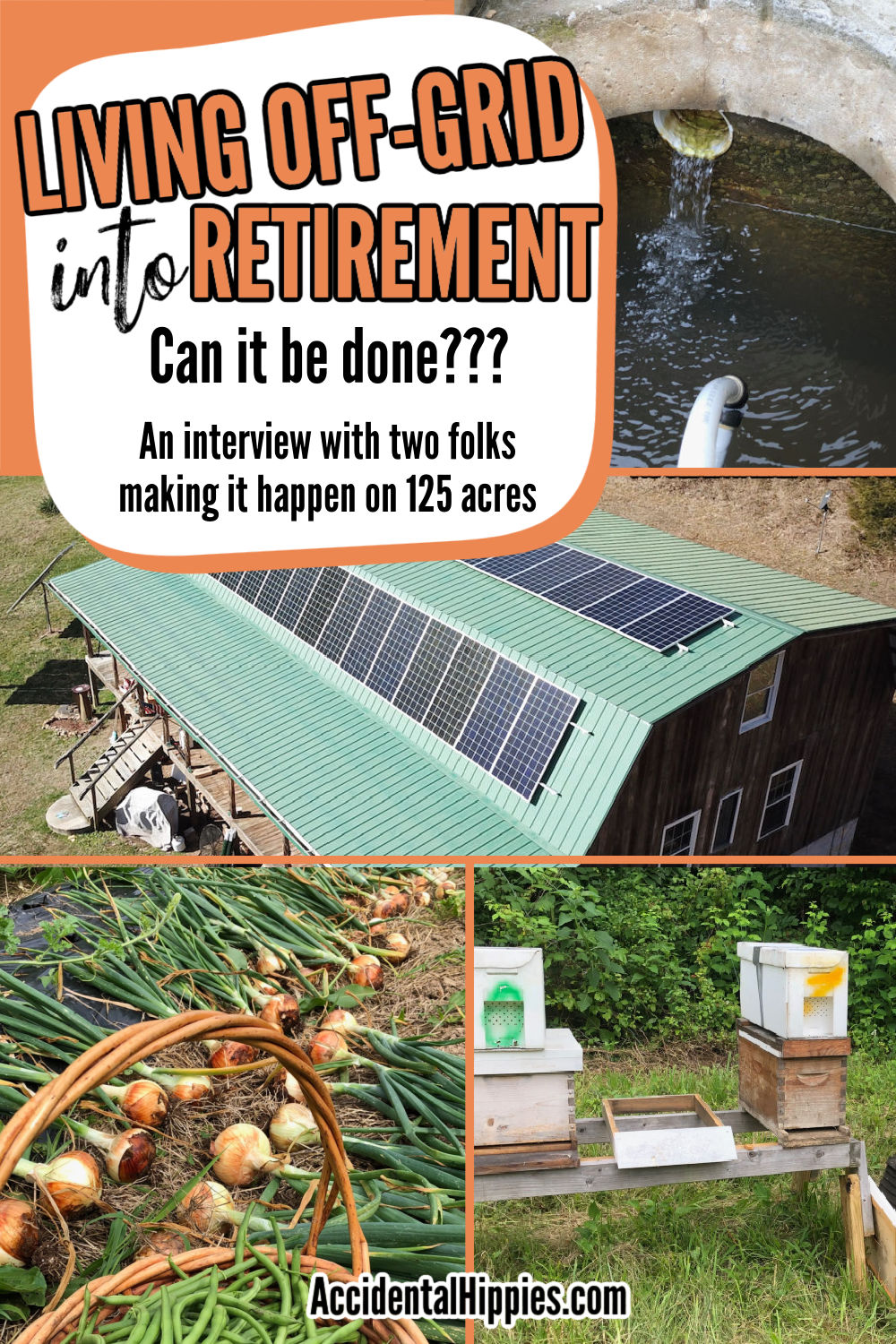
Residing Off the Grid Into Retirement: An Interview With a Couple Making it Occur on 125 Acres
Inform us a bit about yourselves.
We’re Empty-nesters in our late 50’s. We bought 125 acres in 2017. The land is situated in the course of nowhere Kentucky. About 2 hours from the closest massive, metropolitan metropolis, and an hour from two smaller cities with large field shops and leisure. We’re fairly helpful, mechanical, cooking and gardening. Not afraid to tackle greater than we must always.
How lengthy have you ever been residing off-grid and the way did you find yourself there?
Now we have been residing off-grid for 4 and a half years. We wished to purchase rural land and wished to down-size from costly large cities and better taxes. For our retirement years, we wished privateness, a little bit of land, and decrease complete prices. The choice to go off-grid advanced with our land search. Once we discovered our present property, it didn’t have utilities. We researched each what it could price to carry utilities to the property and what it could price and contain to stay off-grid.
Why did you select this particular property and space?
Initially our plan was to purchase land and construct a single-story barndominium on it. We had been residing exterior Philadelphia, and the spouse wished hotter winters – so our focus was looking out the hotter (southern) elements of the nation. We looked for a few years however not discovering something in uncooked land that we favored: NC, VA, TN, and East TX.
Our search standards had been:
- good rising season
- hotter winters
- low taxes
- some terrain/hills and greenery
- good medical/hospitals inside an hour’s drive
- restricted (or no) zoning restrictions
- some land and privateness
RELATED: 18 Issues to Search for in a Homesteading Property
We discovered this property by looking out land websites on the web. We had a funds in thoughts, wished not less than 10 acres, and had been open to transferring wherever was hotter than PA winters. Someday, we simply put our max land funds in, sorted by acreage, and on web page two or three, got here throughout 125 acres in Kentucky. It already had a 10-year-old 1800 sqft cabin however it was listed as a looking property/cabin as there was no operating water or electrical energy.
We took benefit of a enterprise journey to Texas and determined to go to/consider the property and take a look at the assorted states on our listing alongside the way in which to/from. We known as the realtor a few days upfront to arrange the go to and stayed in a close-by city to get a way of the native facilities and providers.
The drive out to the property was attention-grabbing. Step one leaving pavement? Cross a shallow creek to get to the opposite facet. Then over a mile of two-track alongside a proper of means. The property is accessible by a neighbor’s land, down a poorly maintained dust and gravel highway that turns muddy in heavy rain. A 4WD isn’t wanted, however it does present some consolation with mud and snow.
The home had indicators of earlier photo voltaic installs together with a battery financial institution – however it was all lengthy gone with a naked pole for panels, roof-mounted array bolts, empty battery cabinets, and disconnected wires all over the place. It regarded to have had a propane-powered fridge within the kitchen space as properly.
The home sat empty for a variety of years earlier than ending up in a financial institution public sale and being purchased by the realtor to flip.
The realtor mentioned she had a number of curiosity however she couldn’t listing it as a home because it had no water or electrical energy, and most of the people couldn’t get a mortgage for it.
We talked it over and determined this is able to be our subsequent journey. We had been lucky to have the ability to buy the property whereas residing in our previous residence, which gave us time to make the cabin habitable. So we began doing common 12-hour journeys every means round weekends, transferring a bit and organising the fundamentals to make the home habitable. We labored on our new home whereas we prepped our massive suburban residence on the market. Then we used the proceeds from that sale to pay for our new residence and land, and to fund the main off-grid work: water and an enormous photo voltaic system.
RELATED: Off-Grid Photo voltaic – How A lot Photo voltaic Energy Do You Want?
How is your off-grid homestead completely different from a standard residence?
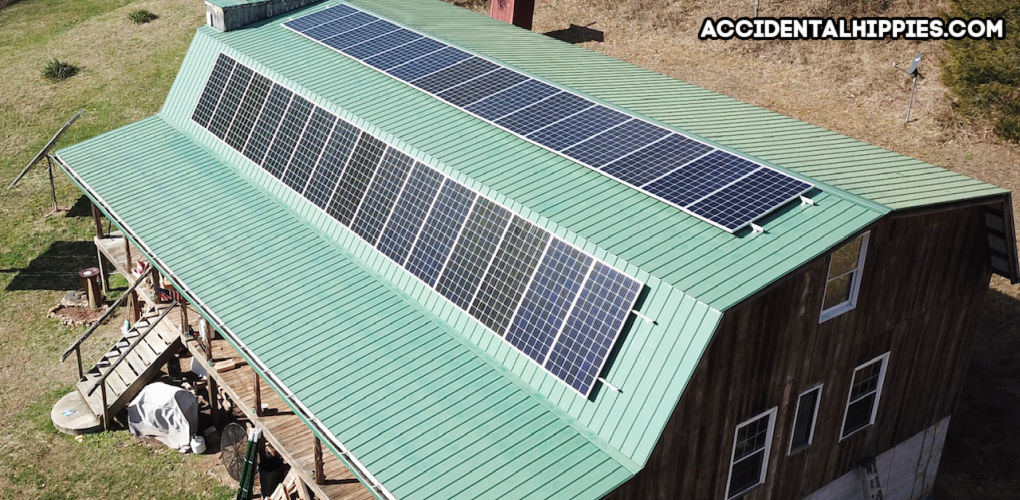
Though our home is off-grid, we’ve all of the facilities of a “typical” residence within the metropolis related to utility energy: fridge, freezer, microwave, dishwasher, washer/ dryer, and air-con. We actually don’t stay any in a different way from once we had grid energy.
A few difficulties we’ve had, have extra to do with our distant location. Our trash drop-off is 10 miles from our home. Our mailbox is a mile and a half from the home (it’s a pleasant stroll!} Getting package deal deliveries to our house is tough however we bribe one of many supply drivers with farm recent eggs.
What off-grid techniques do you’ve?
Photo voltaic supplies our electrical energy (for lights, fridge, freezer, washer, microwave, air-con, warmth pump, and so on).
Water is from a hillside spring close by.
Now we have a 500-gallon propane tank and get a fill annually. Propane is used for warm water heating, cooking (gasoline range/oven), backup warmth utilizing propane heaters, and the garments dryer. We put in propane heaters once we first bought the home as a method to warmth the home to maintain the plumbing from freezing once we weren’t there. It’s also thought of a “secure” type of heating for insurance coverage functions.
We use a wooden range to warmth the home in winter. We’re (slowly) putting in underfloor radiant which we plan to warmth from a heating loop added to our wooden range and possibly add on photo voltaic scorching water on the porch roof. The wooden range covers 70-80% of our heating wants.
On sunny winter days with close-to-full batteries, we are able to use our four-zone mini-split in warmth pump mode to do warmth. We will solely do warmth or AC with electrical energy for 3 days earlier than the batteries run low if there isn’t a daylight to recharge with.
We even have a diesel generator for backup.
RELATED: Air con on solar energy? Sure! Right here’s how we do it.
What are the specs of your present solar energy system? Did you begin with one thing smaller and work your means up?
The quote from the native utility was a minimal of $37k to carry energy again to the cabin. We determined to take a position the identical quantity in photo voltaic and batteries and a big inverter. Our preliminary interim resolution was about 2.4KW of photo voltaic, an 1800-watt 24v inverter, and 600AH of lithium battery at 24v. That lasted whereas we did the essential enhancements and did the fixing up wanted to have the ability to transfer in with fundamental comforts. We stored that after we moved in however it didn’t have sufficient battery or photo voltaic for what we thought of snug residing.
For the upgraded photo voltaic, we bought 10KW of 72-cell photo voltaic panels from a reduced vendor (sunelec.com), did a bunch of analysis on YouTube and from altestore.com, and began laying out an off-grid photo voltaic system based mostly round Outback Energy’s merchandise: an Outback Radian 8KW inverter, three 100A cost controller (two main and a backup) and many batteries.
In researching photo voltaic, the primary concern is load energy consumption and battery life. We determined to go together with lithium as a consequence of its lengthy life, excessive power density, and quick recharge time. Apparently, it’s fairly frequent for folks with lead acid batteries to kill their first set of batteries from overuse whereas they learn the way far they will push them. Lead batteries don’t like being discharged, like being instantly recharged, and don’t take a cost as quick as lithium. The extra you employ lead, the quicker they deteriorate.
We put an enormous battery financial institution of used Tesla battery modules (with acceptable security measures) and have ~1900AH of power storage at 48v, or about 90KwH. The common US residence makes use of 30KWH/day. We’re 16-18KWH/day – with out electrical warmth or A/C.
The previous photo voltaic system that we used for lower than a yr and a half? Effectively, we offered it to a pleasant couple who’ve a weblog and stay in a cordwood residence in Northern KY. They appear to have put it to good use.
What are you able to run with the photo voltaic you’ve?
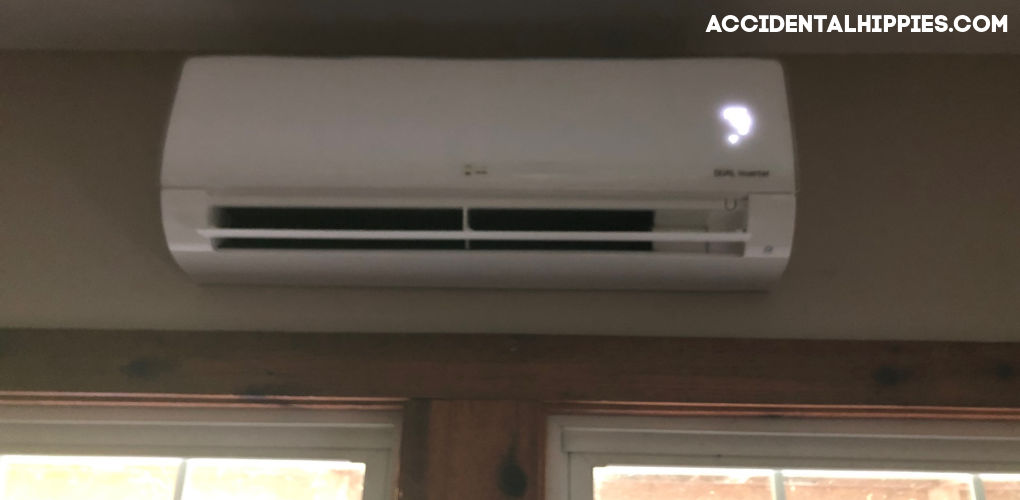
Now we have all of the conveniences: fridge/freezer, chest freezer, espresso maker, toaster, washer/dryer, lights, followers, AC and electrical warmth (restricted), web, safety cameras, computer systems, TV displays (streaming or downloads) and so forth. We don’t actually take into consideration what we’d like electricity-wise. Probably the most we’ve consumed at anybody second is about 5KW out of the 8KW our inverter can produce – and that was operating AC, dishwasher, and laundry + plus lights and stuff. We most likely might have gotten away with a smaller system, however we don’t wish to push issues to the sting.
RELATED: What we ran on our small 1.14 kW solar energy system
Is there something you DON’T run on photo voltaic?
Our garments dryer, range, and water heater are run on propane. All the pieces else is photo voltaic. In hindsight, we might have achieved an electrical dryer, however would most likely do laundry on sunny days – or simply use the photo voltaic dryer (aka clothesline).
What are among the professionals and cons of residing with photo voltaic?
Photo voltaic Execs:
- Quiet
- No utility outages – that are quite common in our rural space
- Free heating/cooling when the solar is shining
- Could be DIY at 1/2 to 1/third the price of a contracted off-grid system
- 30% tax credit score
- Not taking a look at 1.2 miles of phone poles resulting in our residence
- The photo voltaic simply runs itself (principally) however I do must construct an working information for the numerous different.
Photo voltaic Cons:
- Needing to maintain considerably of an eye fixed on our battery financial institution in winter
- The price of batteries – they make up greater than 50% of the DIY price of our system- however ought to final 10+ years if we don’t abuse them.
- The necessity to often run a generator if the solar doesn’t cooperate.
- Having to drill 57 holes in my roof for mounting the photo voltaic racking – no leaks however it makes me nervous over time. If I had been to do it once more, I’d go floor mount.
- No phone poles imply no cellphone traces, so no dependable backup land-line communication or DSL web.
What’s winter like with photo voltaic?
The restricted snow we get can take a few days to clear if the solar doesn’t come out and hit the roof panels – which may result in generator time if preceded by a number of cloudy days.
RELATED: 7 BIG FAQs about solar energy within the winter
What would you do in a different way in your system design when you might?
I’d do Ironridge floor mounts on a hillside and clear among the bushes that shade the home and panels within the early morning and late afternoon. With floor mounts, I might clear panels of snow simpler, panels would run cooler in summer season (extra energy output) and there can be no holes in my roof.
We might most likely go together with a Sol-Ark 10 or 12 Ok all-in-one (or two of them) for the simplified wiring. The Sol-Ark has many fewer connectors than a separate inverter/cost controller config just like the Outback Radian and FM100 cost controllers. Simply battery energy connections, two AC connections (output and generator in), and two photo voltaic string connections. Evaluate that to about 18+ with the Outback setup. Outback makes an all-in-one unit now which I may also have thought of if it had been out however undoubtedly would have needed to get two since they’re solely 5KW every and redundancy when off-grid is vital.
How do you get water?
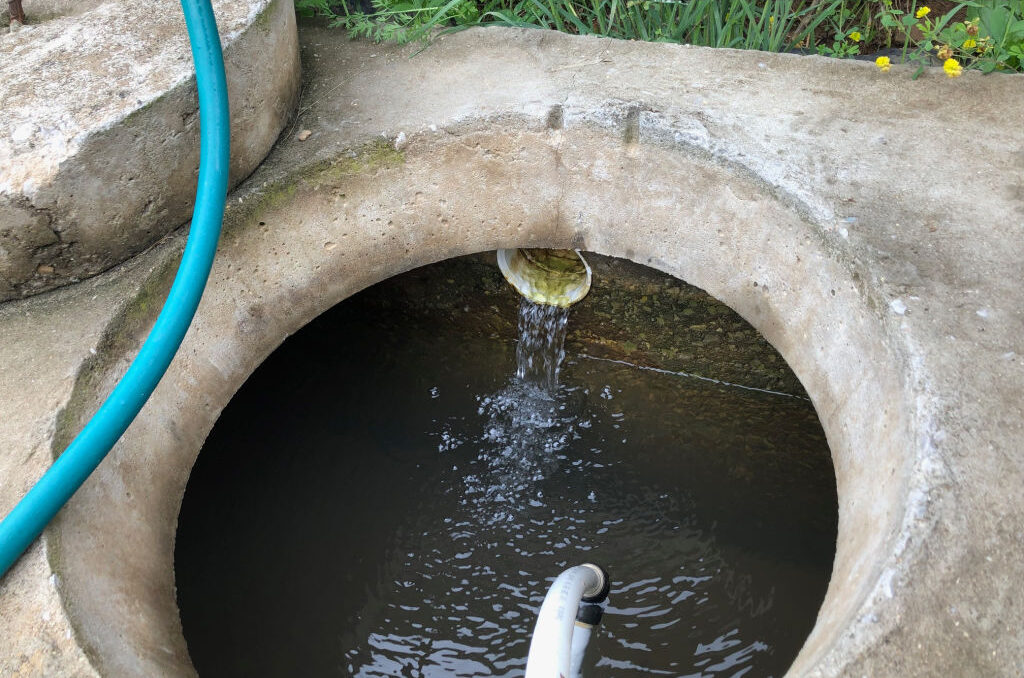
Water is from a close-by hillside spring just a few hundred toes from the home. We added a spring home to maintain the wildlife and particles from the water. The spring gravity feeds a 500-gallon cistern one other 200’ downhill from the spring. We use a solar-powered pump to elevate the water virtually 500’ throughout and 150’ as much as an 1100-gallon tank that sits above the home. The home water is gravity fed from the massive hillside tank. We added a pressure-boosting pump and changed all of the damaged home plumbing with PEX. Sizzling water is a propane-fed Rinnai tankless setup.
For ingesting water, we use a 7-stage reverse osmosis system with a UV stage. Water has confirmed unreliable for our neighbors too – it’s not simply utility energy that’s shaky out in rural land.
How do you cope with wastewater?
Black waste water goes right into a septic system. The home had one fortunately (we had nightmares about discovering we had a cesspool someplace). Bathe, sink, and washer water (gray water) goes right into a drain area and irrigates our backyard/orchard.
RELATED: Easy methods to cope with wastewater on a rural property
How are you at present getting web? What has web entry been like for you up to now?
Ah, web. There isn’t a cell protection or web out there at our location.
Should you climb the 300’+ hills that encompass the home, you may get mobile phone service however no quick information. Initially, we picked up a Verizon residence LTE router and ran 1000’ of out of doors community cable up the hill to a tall tree. I picked up an exterior high-gain antenna and pointed the antenna on the closest city with Verizon LTE service – about 9 miles away because the crow flies or about 18 miles by automobile. The community cable ran by two repeaters and carried energy and information to the router. The LTE information connection gave us 3-5 MB obtain.
RELATED: Easy methods to Get Web Off The Grid
Then we acquired ViaSat Enterprise – which is concentrated on greater satellite tv for pc web speeds throughout enterprise hours. We stored the LTE reference to its barely decrease price and information cap as backup. ViaSat labored finest for my distant work/consulting job and fundamental web site/social media. Whereas lots of people wish to complain about ViaSat, the marketing strategy gave us 25MB down and 75GB/month for $175/month – and so they delivered.
ViaSat enterprise was out there the place their “limitless” residential plans weren’t. Should you don’t stream video, the 75GB information cap was fantastic for e-mail, looking, distant work (not video calls), and social media. We additionally used the web for LTE calling over the web. Sadly, squirrels or mice stored chewing on the cables going up the hill, so we ended up retiring that to concentrate on ViaSat when it proved dependable.
Two years in the past, I rented an enormous trencher and with assist from a pal ran 1.5M of direct burial fiber optic cable from the final Phone pole closest to our property, alongside the suitable of means, to our home. This allowed us to change to xDSL at 25MB/2.5MB for $60/month. The modem tools lives in a small field subsequent to the pole (pleasant neighbor’s land) and is solar-powered. As quickly as that was operating reliably we canceled ViaSat.
The one draw back is when native utility energy outages hit (and so they do hit regularly) the xDSL community goes down because the tools up the highway doesn’t have backup energy. Right here we’re with our lights on – and no web. The large change from DSL was the flexibility to stream movies and flicks on demand as there have been no extra information caps.
We joined the Starlink waitlist 18+ months in the past, final month, Starlink supplied us their “finest effort” plan for $110/month with decreased speeds over residential prospects. Speeds have usually been within the 10-30MB vary, however we’re retaining the cheaper DSL as a backup. Their Satellite tv for pc protection isn’t excellent and full but – so we get a number of very quick outages a day. I’ll most likely ‘mix’ the DSL and Starlink right into a bundled hyperlink to get 35-50Mb service and redundancy.
I’ve began working full-time remotely this yr and have wanted the velocity and reliability of the DSL service. Having backup web can be nicer.
From early on, for emergency communications, we added a mobile amplifier and exterior directional high-gain antenna on our roof. The product is from Cel-Fi-Go X ($1000) and has been glorious. We went from no cell service on the home to adequate service: permitting for cell phone calls in the home and a few low-speed information, however it’s solely 90%. It really works higher in winter than in summer season as there are fewer leaves on the bushes blocking the sign. For many voice communication we use Verizon wifi calling.
Is there something you’ve in your house that most individuals wouldn’t anticipate finding in an off-grid residence?
I feel it surprises folks after they go to on a scorching and humid sunny day and are available inside to seek out cool AC and ice cubes for his or her drinks.
What sorts of homesteading actions do you do?
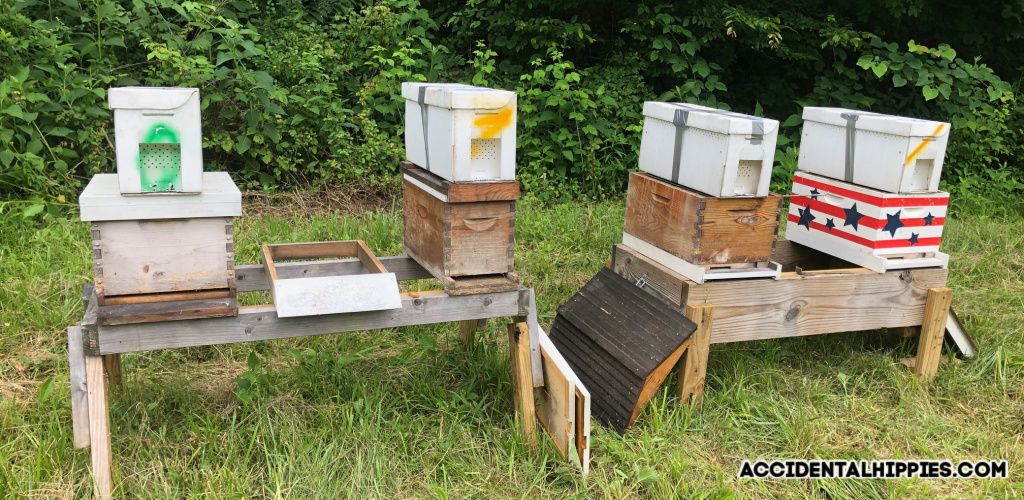
For homestead actions, we’ve 6 acres of cleared land. Now we have chickens for meat and eggs, and an enormous meals backyard (90×30’) that feeds us and the deer. Now we have planted fruit bushes (but to see a lot in the way in which of fruit), berry bushes, and grapes. Wild blackberries abound so when you don’t thoughts just a few scratches it’s enjoyable to gather in the summertime. We will/protect meals each summer season, making good and fast meals for the following yr. We get milk from a neighbor’s cow and usually break up an area pig or cow annually with mates, half every. These fill our chest freezer and we eat it down over the yr. And don’t overlook bees for honey!
What are your plans as you head into your retirement years? Any insights on off-grid residing at completely different ages and phases?
Now we have slowly been enhancing the home with the concept of “getting older in place” in thoughts. Particularly, we selected a home with a single-floor primary residing space with broad halls and doorways for our senior years. Now we have began a rest room addition which can embrace a curbless bathe for ease of entry.
What is difficult about residing off the grid that ought to you take into account as you age?
Maintaining with all of the land. Simply bush-hogging our cleared space and maintaining the suitable of means/driveway takes important money and time. The suitable of means/driveway appears to swallow a number of a great deal of gravel each couple of years.
Bush-hogging and mowing within the peak of the rising season throughout 5-6 acres is a full day each week or two. Rising your individual meals isn’t simple. Gardening requires day by day consideration and bodily labor. You might be continuously preventing the climate, wildlife, and weeds. There’s additionally the tools obligatory: tractors, mowers, and trailers. All the pieces wants upkeep and restore. Issues break extra usually than we’re used to. The tractor is down once more with a foul leak, or the bush-hog wrapped fence wire across the spindle, or a tree fell throughout the suitable of means. It’s all the time one thing. Simply attempt to perform a little day-after-day.
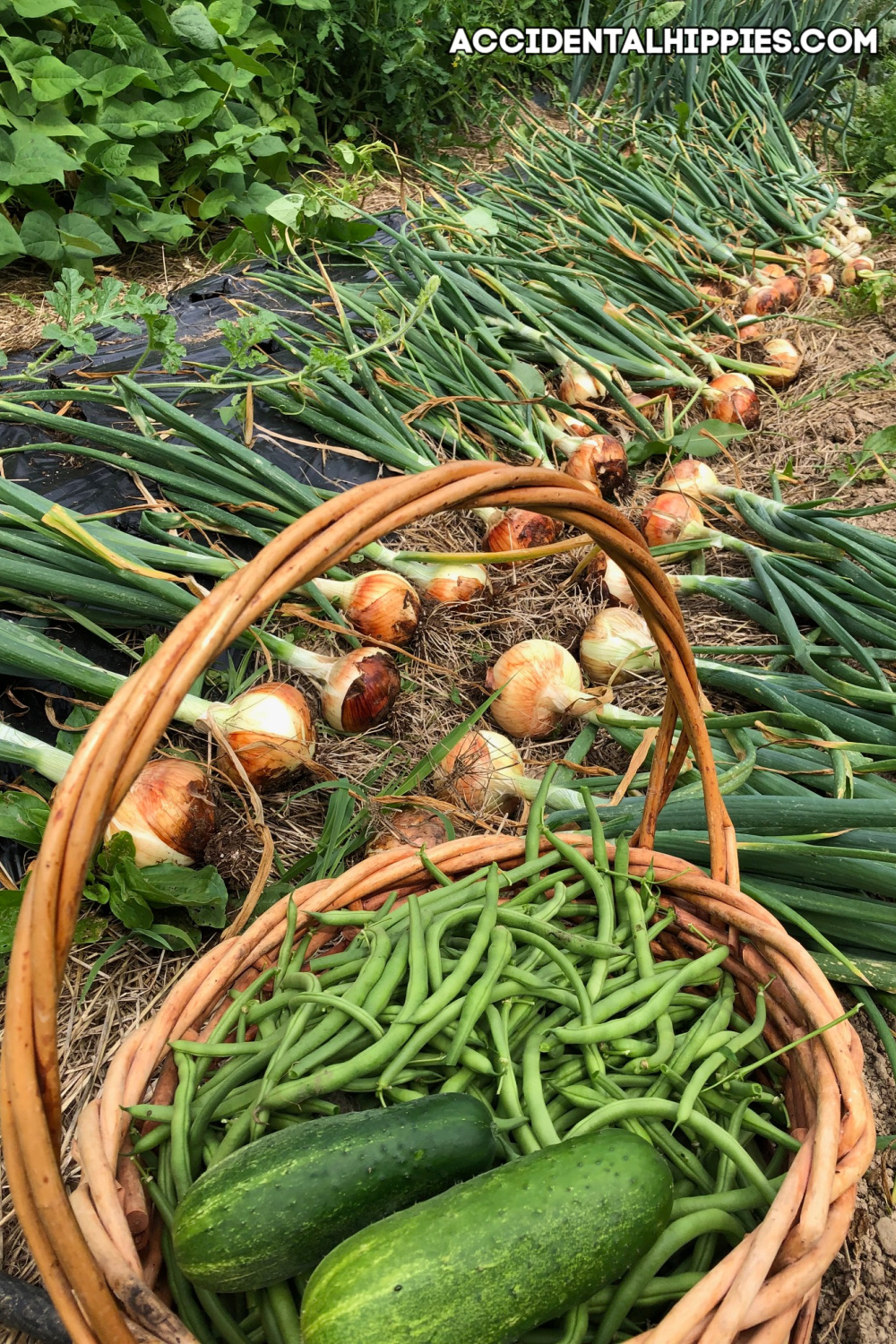
Do you miss something about residing ON the grid?
Easy accessibility to consuming out. All the pieces is a visit. We hold a shared and synchronized listing on our telephones for issues we’d like/need from city or the ironmongery shop, so we don’t waste a visit. Every journey takes just below 1 hour spherical journey to the closest small city. You don’t need to get residence and notice you forgot to get the pet food!
It’s a number of work doing with out maintained roads, no cellphone service, no electrical energy – besides what you make or can herald – to construct a life off-grid. YouTube doesn’t present the fact of hours and hours of land clearing, backyard work, or the devastation when a predator makes it into your rooster coop. Good neighbors go an extended approach to a better transition vs. going it alone.
What recommendation do you’ve for anybody contemplating homesteading off the grid?
It’s not simple! It takes time and power to construct a homestead. It takes extra time and power to keep up it. If you can begin it if you find yourself youthful, it is going to be a lot simpler than in your later years.
Put apart funds often for an emergency. Finances now for the following set of batteries – they’ve restricted life – even when it’s 10 years. Panels may final 20 years. Panels and batteries are each are important bills when off-grid.
Set your home up for residing in your later years. Both ground-floor entrances, ramps, or easy issues like broad hallways and curbless showers could make life simpler as we age.
Do your analysis before you purchase! Analysis your new city, analysis your zoning codes, the place is the closest grocery retailer(s), and the place the closest hospital is. When you’ve got shared roadways or easements, who’s liable for upkeep? Will your shared neighbors work with you on highway maintenance?
Should you warmth with a wooden range, verify your insurance coverage. Many insurance coverage corporations is not going to cowl houses with wooden stoves as their primary warmth supply (or cost greater premiums).
RELATED: Getting Insurance coverage for Your Off-Grid Construct
Be sure to have a very good water supply, a spot for septic, and good southern publicity for photo voltaic.
The place will you place the backyard? The place will you place the barn/pastures? Be sure property traces are properly marked, and that easements or proper of the way are properly documented.
Get extra photo voltaic and batteries than you suppose you may want. Should you can afford it, go together with lithium to your battery expertise. Lithium will last more and cost quicker than lead.
Should you want web entry to do your job or stay remotely comfortably, determine your wants upfront and take a look at it earlier than you progress out to the center of nowhere. I first examined my LTE-based web resolution at our previous home earlier than transferring it to KY. I knew it could work and that we might have a approach to make/obtain calls and get web for entry to work.
Should you plan to maintain animals, do your analysis! Have a plan and have your infrastructure in place before you purchase the animals. Have a fundamental understanding of what’s wanted to maintain them wholesome and secure. How a lot house do they want? What kind of atmosphere? What’s going to you do in the event that they get sick or injured? The place is the closest vet? How will you get the animal to the vet?
Make mates and construct group. All of us assist one another out down right here. I do know if we’d like one thing our neighbors will make sure to assist, and so they know they will come name on us in the event that they want something. All of us look out for one another.
There you’ve it!
Recommendation from precise folks residing off the grid who aren’t younger YouTube stars of their 20’s and 30’s.
Whether or not it gave you the hope and encouragement to know you’ll be able to retire off-grid, or whether or not it made you rethink your plans, I hope you discovered their recommendation useful. It’s so vital to do your analysis and make choices which might be actually proper for YOU.
Should you need assistance planning and brainstorming for what your subsequent steps are, I extremely encourage you to get on the e-mail listing to entry our free Planning and Budgeting PDF Information. It’s the very same course of we used once we had been weighing our choices of going off-grid once we acquired began and I’m positive it will probably allow you to too.
Be taught extra about our unique cordwood homestead mission right here. And make sure to be part of us on Pinterest, Fb, and Instagram for extra homesteading goodies that don’t essentially make it to the weblog. Thanks for studying!



